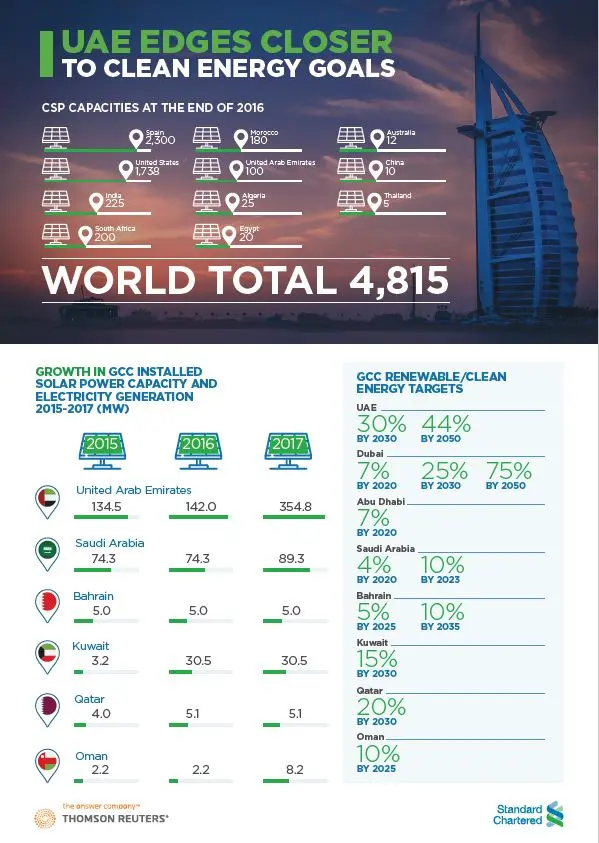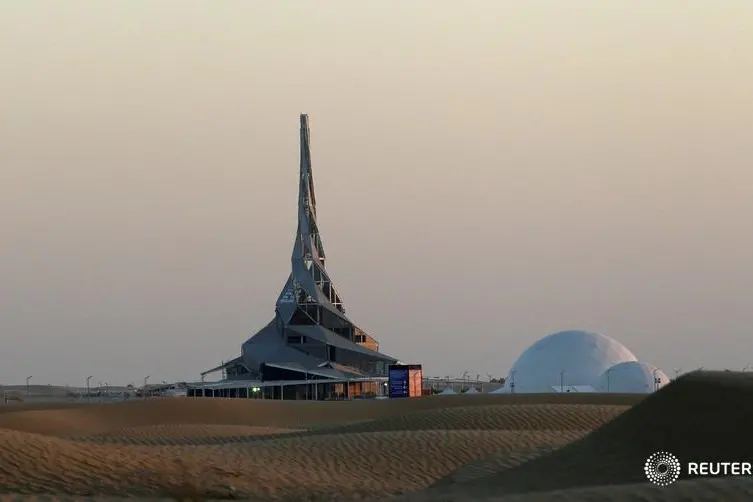PHOTO
Dubai in May took another big step toward its goal of becoming the world's greenest city when the inauguration of the 200MW first stage of the 800MW third phase of the Mohammed bin Rashid Al Maktoum Solar Park brought the emirate’s clean energy share of its total installed capacity to 4 percent.
This follows Sheikh Mohammed bin Rashid Al Maktoum, Vice President and Prime Minister of the United Arab Emirates and Ruler of Dubai, in March breaking ground on the solar park’s 700MW fourth phase.
Dubai plans to have the world's lowest carbon footprint by 2050, when it targets clean energy sources such as solar power to account for 75 percent of the city's power output, up from a targeted 7 percent by 2020 and 25 percent by 2030.
Further capacity to be added over next two years
It will add further clean energy capacity when the second and third stages of the third phase, each supplying 300MW, are completed in 2019 and 2020, respectively.
The solar park’s third phase achieved a world record in June 2016 when a bid of just 2.99 US cents per kilowatt-hour was accepted from a consortium led by Abu Dhabi clean energy company Masdar and Électricité de France (EDF) Group. This was nearly half the winning bid for the plant’s 200MW second phase, which at 5.84 cents was itself at the time a world record low.
The Mohammed bin Rashid Al Maktoum Solar Park was launched in 2012 as part of the Dubai Clean Energy Strategy 2050 and has already claimed a number of world records. The sprawling solar park is the largest single-site generator of solar energy in the world, with a capacity to produce 5,000 MW by 2030. It is also the largest renewable energy plant in the Middle East. Once complete in 2030, it will cover 214 square kilometers.
Fourth phase also breaking records
The fourth phase is also breaking world records. It will have the world’s tallest solar tower, at a height of 260 meters, and the world’s largest thermal storage capacity. The first stage of the concentrated solar power (CSP) fourth phase will be commissioned towards the end of 2020.
Concentrated solar power stores power that can be released when the sun is not shining, such as at night. Although more expensive than solar PV, Dubai's solar thermal technology will allow up to 15 hours of storage, meaning it can release electricity into the national grid 24 hours a day.
Demand for power is rising in the Middle East, but the precariousness of fossil fuel dependency as shown by the crash in oil prices in 2014 and the political fallout of climate change is making renewable energies such as solar power more attractive propositions, particularly as prices fall, and none is falling faster than solar. In April 2016, the Gulf Cooperation Council states pledged to pump $100 billion into renewable energy projects over the following 20 years.
The $3.8 billion fourth phase has achieved the world’s lowest levelised cost of electricity, at 7.3 cents per kilowatt-hour.
Solar power costs tumbling
In many parts of the world, the cost of solar power is plummeting to a point where it will soon meet a rising cost for electricity generated by coal or gas. Part of the reason for this is that once a solar plant is built, the marginal cost of the power it produces is next to nothing, whereas for fossil fuels, these resources need to be constantly supplied. In 2016, the amount of solar photovoltaic capacity added around the world rose around 50 percent, continuing a stellar growth from little more than zero at the turn of the millennium.
One concern about solar power has been that it is only available when the sun shines, and that because of this it will still be necessary to maintain base load generation from fossil fuels. But this objection collapses in the face of CSP.
Indeed, CSP holds so much promise that the International Energy Agency predicts up to 11 percent of global electricity generation could come via CSP by 2050. Spain and the United States account for nearly 90 percent of installed CSP capacity, but by 2016 there were facilities being built in Saudi Arabia, Australia, Chile, China, India, Mexico and South Africa among others, while Morocco brought online the 160MW first phase of its Noor-Ouarzazate solar power station, to be built by a consortium led by Saudi private electricity company ACWA Power. This plant will grow to 580 MW when fully operational by the end of 2018, making it the world's largest CSP plant.
Abu Dhabi is similarly committed to increasing its share of renewables in its energy mix, and is home to Masdar City, which it plans to be the world’s most sustainable eco-city. The Masdar City Solar Photovoltaic Plant is the largest of its kind in the Middle East, producing about 17,500 MW-hours of clean electricity a year.
Masdar has also contributed a number of renewable energy world firsts over the past decade including Shams 1, which at the time of its inauguration in 2013 was the world's largest CSP plant. An even larger CSP plant will be built in Abu Dhabi for a total cost of 3.2 billion UAE dirhams ($870 million). The Noor Abu Dhabi is planned to generate 1,177 MW from the second quarter of 2019. Masdar is also developing a waste-to?energy plant in Sharjah to assist in that emirate's effort to reach its zero waste-to-land?ll target by 2020 and the UAE to achieve its 2021 goal of diverting 75 percent of solid waste from land?lls.














